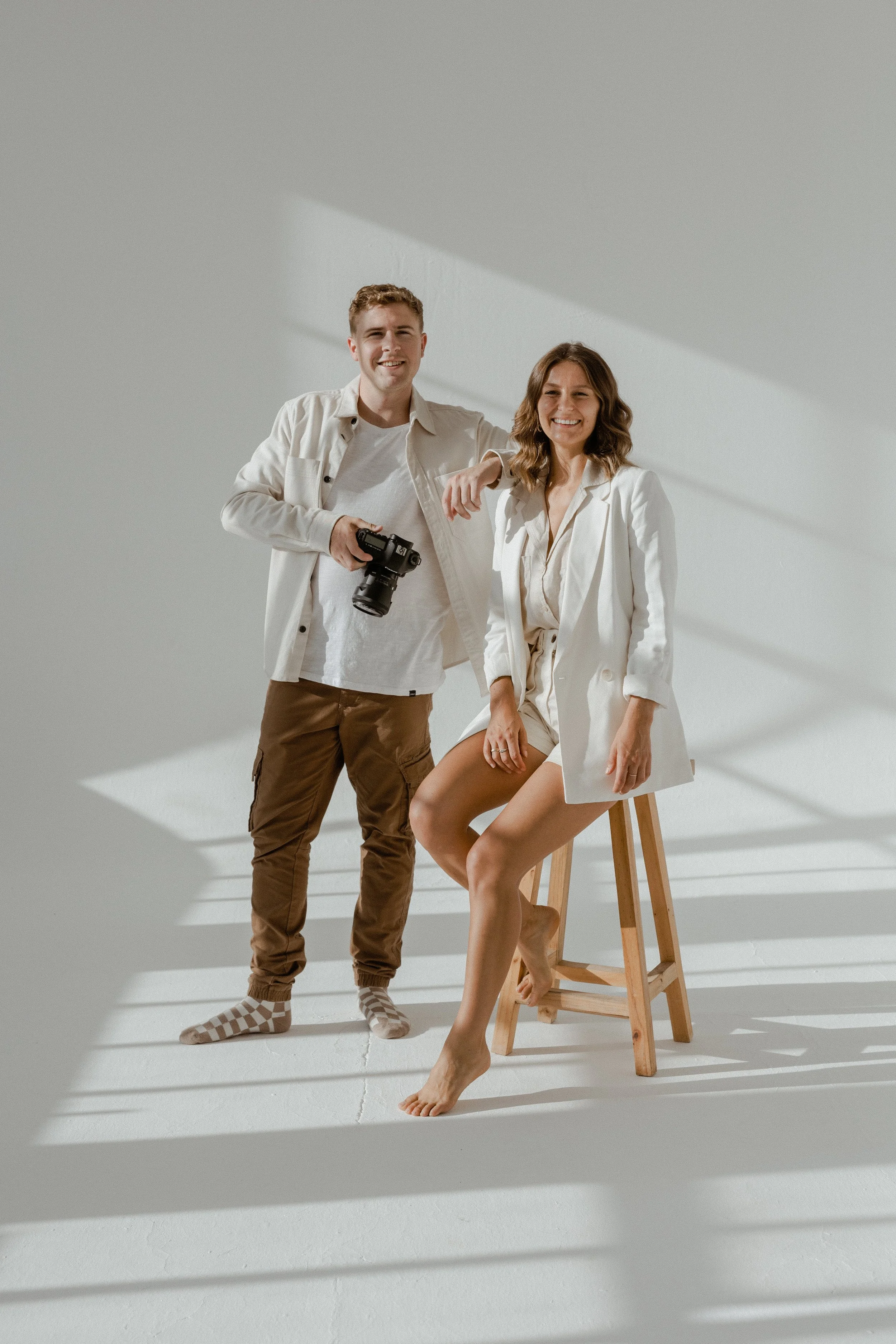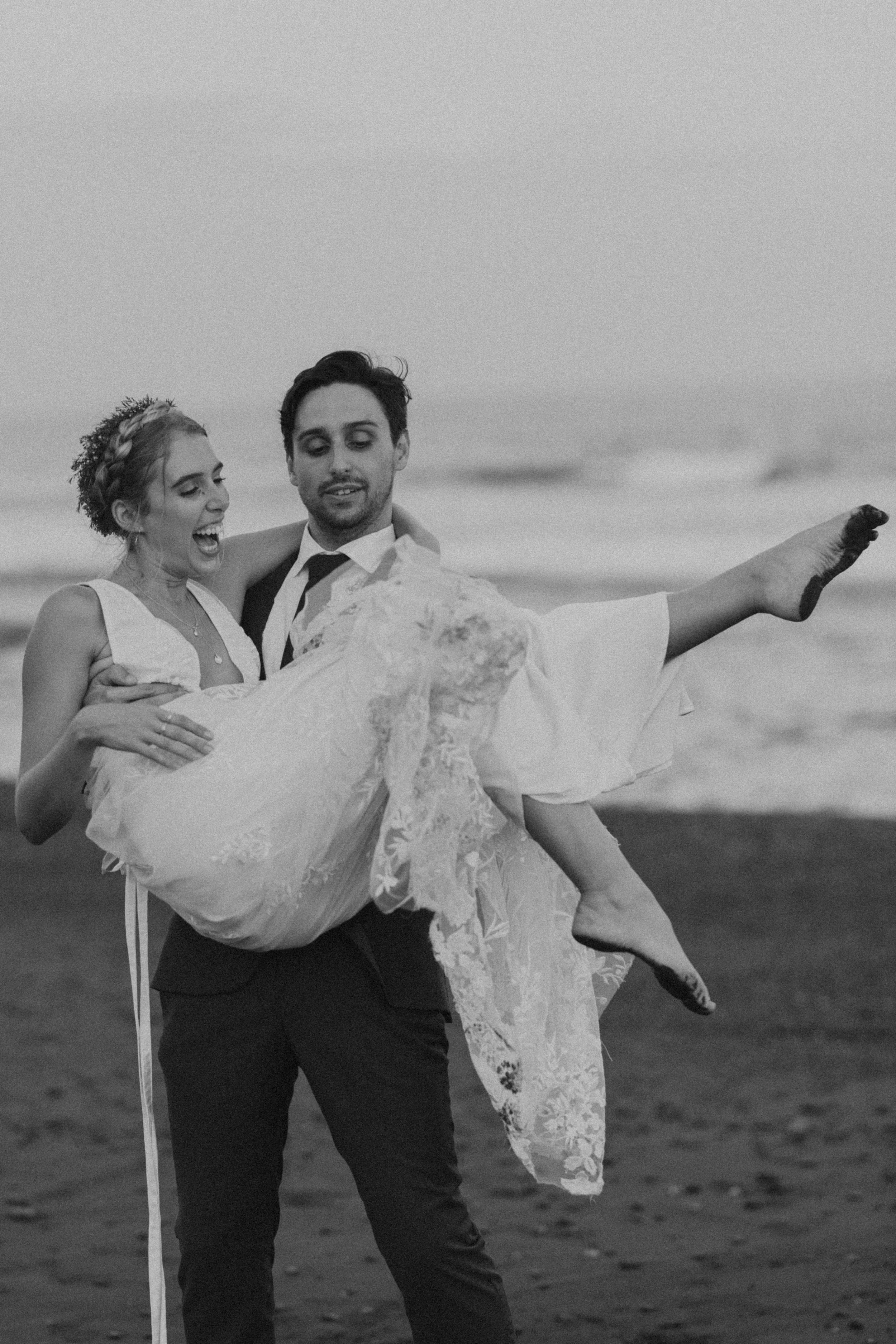THE SECOND SHOOTERS GUIDE
Your guide to being a successful second shooter that photographers want to book!
IN THIS GUIDE I’LL TEACH YOU THE FOLLOWING
PRE-WEDDING COMMUNICATION AND PREP
ON-THE-DAY EXPECTATIONS & HOW TO SUPPORT AND HELP THE LEAD PHOTOGRAPHER
POST-WEDDING DAY TIPS TO LEAVE A LASTING IMPRESSION

I receive messages regularly from aspiring photographers, brimming with excitement and eagerness to learn. To assist you in navigating the intricacies of a wedding day and to help you shine alongside me, I've crafted this handy guide.
By following these tips, you'll not only impress your lead photographer but also position yourself as a sought-after second shooter. This can open doors to more opportunities, allowing you to fill your calendar with weddings and eventually pave your own path in the industry!
Reflecting on my own journey, I seized every chance to second shoot early in my career. It was my way of soaking up knowledge and honing my skills, preparing myself for the moment I stepped into the spotlight at my own weddings. These experiences were invaluable, laying the foundation for my success in establishing my own brand.re vital to my success in building my own brand.
BEFORE WE BEGIN…
Reaching Out to a Photographer: I absolutely adore getting emails from fellow photographers eager to collaborate with me, especially when they share how they can contribute to the magic of a wedding day. It's heartening to see the enthusiasm of up-and-coming talents reaching out to gain experience, and I'm thrilled to be a part of that journey!
However, how you approach me plays a big role in whether we'll work together. Your email to a photographer is essentially your job application and resume, so it's crucial to invest time and effort into crafting it.
I recently received an email that began with a generic "Dear [insert photographer name]" followed by a copy-pasted message. It was evident that no effort was made to personalize it, and it left me questioning whether this person would truly invest themselves when faced with challenges on a wedding day.
Now, I'm not suggesting that you shouldn't reach out to multiple photographers, but taking the time to personalize each email is key. Do your homework on each lead photographer, explore their work, style, and even their preferred gear. Mention specific aspects of their work that resonate with you and explain why you're eager to collaborate and how you can contribute value. Remember, it's a two-way street, and you need to show how you can benefit your potential employer too.
Adding Value: Sharing a list of your gear can be beneficial as it gives the photographer insight into your equipment and skill level. Additionally, communicate your past experiences, your eagerness to contribute, and demonstrate a strong work ethic and reliability. Remember, this is the photographer's business, and they'll want the best to help them grow.
Proving Yourself: Be prepared to demonstrate your abilities. Established wedding photographers often have a trusted team that works seamlessly together, making weddings smoother even in high-stress situations. Don't expect to start shooting right away; you may be asked to assist on shoots or accompany them to weddings without handling a camera initially. This is an opportunity to show your willingness to add value and prove yourself.
Cancellations: I typically book my second shooters well in advance, usually at least three months before the wedding. I require a one-month notice, both written and verbal, in case of cancellation, and I appreciate assistance in finding a replacement.
How and why a second shooter cancels can greatly impact whether I'll work with them again. Communication is key here. I've experienced some unfortunate cancellations, including receiving a last-minute voice note citing family commitments. In such situations, it's essential to immediately inform the photographer, assist in finding a replacement, and offer a sincere apology.
Pre-wedding communication about cancellation expectations ensures clarity and helps maintain a professional relationship.
PRE-WEDDING DAY PREP
Keep Your Focus on the Couple: First and foremost, your mindset plays a crucial role when working as a second shooter. It's essential to recognize that your primary role is to support the main photographer and ensure the couple's day is captured beautifully.
Your aim isn't just to build your portfolio, although that's a nice bonus. The main photographer hires you to meet their specific needs and expectations for the wedding day. It's glaringly obvious when a second shooter is only focused on themselves. To succeed in this industry, understanding that it's service-based is key. Your willingness to help and serve others will truly set you apart.
Communication Before the Big Day: Open communication with the main photographer is vital. Discuss their style, preferred lighting setups, and essential shots they aim to capture. Every photographer has different expectations, so knowing what's required of you beforehand is crucial.
As a second shooter, take the initiative to do some research on your own. Inquire about expectations, notable details, and dynamics within the family or bridal party that may need attention. Proactively seeking information will help you better support the main photographer in challenging situations and ensure you're aligned with their vision.
Regarding image usage, it's essential to respect any guidelines set by the lead photographer. Most importantly, remember that these images belong to their business. While some photographers allow second shooters to use images for their portfolios, many do not. Always clarify this before the wedding day.
Here are some general guidelines and restrictions I have for my second shooters:
All rights belong to the main/lead photographer. If allowed to post, wait until the full gallery has been sent to the client.
Tag the lead photographer in your caption, not on the photo itself.
Avoid claiming weddings as your own or using cheeky wording in your posts.
Refrain from following or tagging couples, bridal parties, guests, venues, or vendors.
Get Acquainted With the Venue: While scouting the venue beforehand isn't always possible, conduct some online research. Familiarize yourself with the lighting, layout, and potential shooting angles. This preparation will boost your confidence on the day and enable you to capture the best moments from various perspectives.
Pack Your Gear Ahead of Time: Your camera gear is your lifeline, so preparation is key. Ensure your equipment is fully charged, and your memory cards are clean and formatted. Showing up with uncharged batteries, unformatted cards, or dirty lenses screams unprofessionalism and puts you at risk of making mistakes on the wedding day. Being prepared will set you up for success and ensure you capture all those special moments seamlessly.
|| ON THE
WEDDING DAY ||
1 Time Management Matters: Punctuality is a non-negotiable for me when it comes to second shooters. Being late not only reflects poorly on your reliability but can also disrupt the entire flow of the day. Remember, weddings wait for no one.
To ensure smooth sailing, always aim to arrive at least 10-15 minutes early. I personally make it a habit to show up a good 45 minutes before the scheduled time. This buffer allows for any unexpected delays like traffic or unforeseen mishaps. Being early is your best defense against the unexpected!
2 Dress for Success: As a second shooter, you're an integral part of the wedding scene, and your appearance matters. Dressing professionally not only shows respect for the occasion but also reflects positively on your work ethic.
Start by checking in with your lead photographer about any specific dress code preferences. For instance, I recommend opting for smart, collared tops and dark-colored attire to blend seamlessly into the background.
Additionally, ensure your grooming is on point with neatly styled hair, clean nails, and fresh breath. Carrying a spare change of clothes and a warm jacket is a smart move, especially for outdoor or evening events. And don't forget comfortable yet supportive footwear to keep you going all day long.
3 Fuel Up for Success: While some lead photographers may provide snacks, it's always wise to pack your own to keep your energy levels up throughout the day. Everyone has different needs, so it's best to be prepared.
I make it a priority to supply snacks and plenty of water for my team to ensure they're performing at their best. However, not every photographer may offer this, so it's essential to communicate and plan accordingly. Remember, staying nourished is key to staying focused!
4 Follow Instructions: As a second shooter, you'll often be tasked with various non-camera-related duties throughout the day. Embrace these responsibilities with a positive attitude, knowing that they contribute to the overall success of the event.
Whether it's assisting with gear, running errands, or lending a helping hand, follow the lead photographer's instructions diligently. Most photographers have a system in place to ensure everything runs smoothly, and your cooperation is vital in executing their vision.
5 Capture Candid Moments: Candid shots are the heart and soul of wedding storytelling, and as a second shooter, you play a crucial role in capturing these authentic moments. While the main photographer focuses on formal shots, seize the opportunity to capture candid emotions and interactions.
Move through the crowd with confidence, exploring different angles and perspectives to provide variety in the final collection. Remember to prioritize authenticity and subtlety, ensuring your shots complement the main photographer's work seamlessly.
6 Be Proactive and Resourceful: Weddings can be unpredictable, so it's essential to be adaptable and forward-thinking. Anticipate needs and be ready to lend a helping hand wherever necessary.
Whether it's fixing wardrobe malfunctions, assisting with setup, or capturing behind-the-scenes content, stay proactive and attentive. Attention to detail and a positive attitude will set you apart and contribute to a memorable wedding experience for all involved.
AFTER THE WEDDING DAY
1 Embrace Learning and Feedback: After each wedding, take a moment to express gratitude to your main photographer. Reflect on the valuable lessons you've learned, the income you've earned, and the creative opportunities you've had while capturing such a special day. It's truly an awesome experience!
Don't hesitate to ask your lead shooter for feedback on your performance. Embrace constructive criticism as a pathway to growth. It may feel daunting, but seeking and accepting feedback is essential for professional development.
2 Respect Photo Guidelines: Respect any restrictions set by your lead photographer, whether it's regarding posting photos or tagging protocols. Adhering to their guidelines shows professionalism and consideration for their business practices.
Avoid tagging or following individuals associated with the wedding, including the couple, vendors, and guests. This helps maintain clarity about your role and prevents any confusion or complications for the lead photographer. Transparency is key, so if any issues arise, communicate openly with your lead photographer.
3 Enjoy the Experience: Approach every task with gratitude and enthusiasm. Maintaining a positive attitude will not only enhance your experience but also contribute to your success in the industry.
I've shared insights that I wish I knew when starting out, hoping they'll be beneficial to you. Excelling as a second shooter opens doors to more opportunities, paving the way for a fully booked calendar of wedding bookings in no time!



